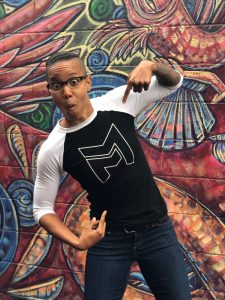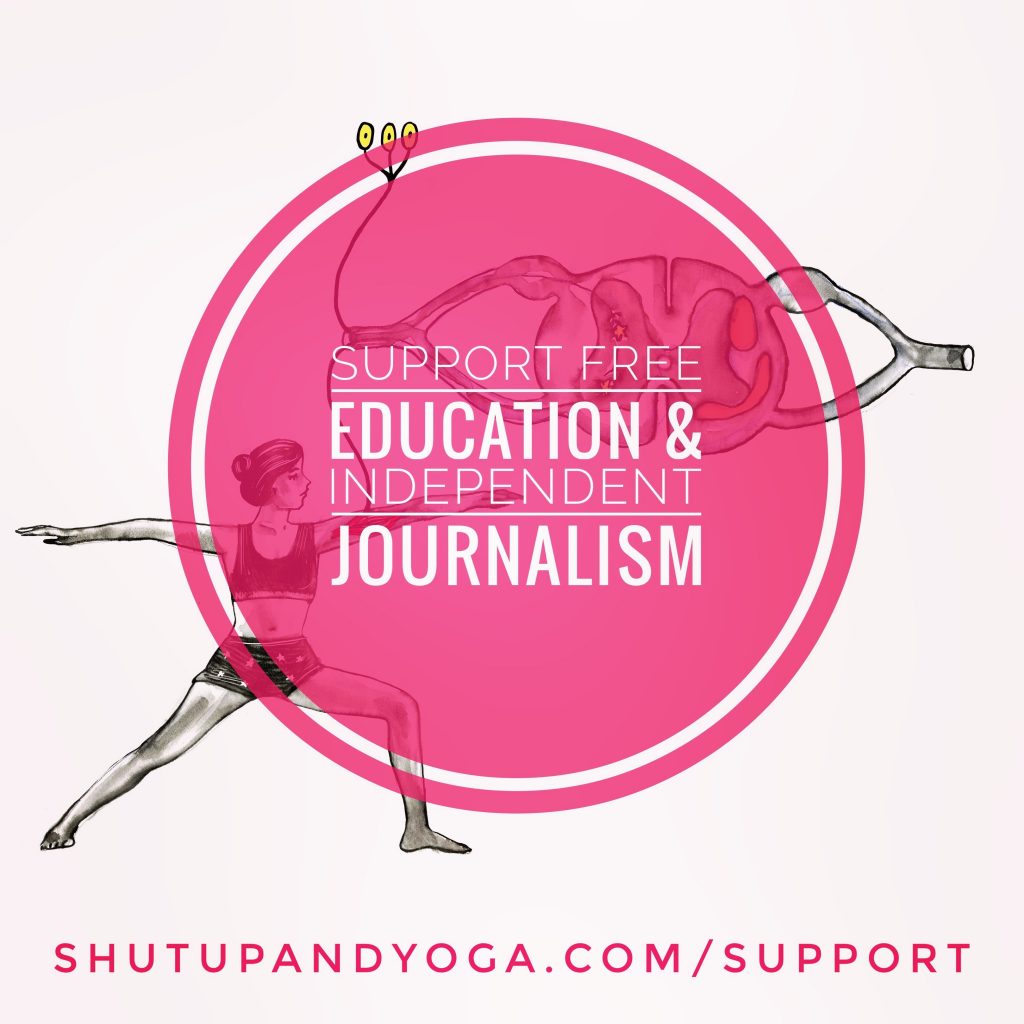@themovementmaestro
We were delighted to interview Shanté Cofield aka the Movement Maestro, physical therapist, passionate change maker, rock tape instructor, social media lover, and one of the most energetic people we’ve met! She tells us all about what helped her give direction to her journey as a PT, what yogis can learn from her approach to movement, the importance of assists, and her love for freedom and Instagram (and the former on the latter).
Shante’s Movement Journey
Tell us more about your journey. Did you always know you wanted to get into the healthcare field? What kind of education did you receive to become a movement educator? Do you think it was excellent/satisfactory/not enough?
I’ve played sports my entire life, and since I was a young kid, I knew I wanted to be in the medical field. For years, all the way through my senior year of college, in fact, I wanted to be an orthopedic surgeon. Looking back, I’m not entirely sure why. I think because I like fixing things and solving problems, and it might have also been in part for the bragging rights of being a ‘doctor.’ My senior year of college I decided that I didn’t want to spend the rest of my life in school (go to med school and then do a gazillion years of residency), and when my advisor suggested I go to physical therapy school, I said why not. So I applied, got in, and then spent the next three years hating it, questioning my decision and regretting not having gone to med school.
I had gone to undergrad at Georgetown University where I was a health science major, and they ABSOLUTELY prepared for grad school. I truly could not have asked for better schooling. I attended grad school at NYU, and while rigorous, I had found undergrad to be more challenging, which is in part why I questioned my decision to go to PT school instead of med school. I graduated with my doctorate in physical therapy and went on to practice… and hated it. It wasn’t until I took a RockTape course about 5 years after I graduated that I realized I could do more, there was more to physical therapy, and I had options. PT school is designed to make you a safe practitioner and get you to pass your boards. It did exactly that. It was the independent learning that came after that really inspired me, opened my eyes, and gave me wings.
Related to your Daily Maestroism #991, “Trainers, coaches, yoga teachers, and the like are first-line healthcare providers. We need to make sure they have access to the education that supports that reality.” – how should modern movement education look like?
Modern education needs to be inclusive, encouraging collaboration, NOT competition. We all need to be speaking the same language so that we can help the person who matters the most: the patient. Additionally, it’s important that we have some understanding of what other disciplines are doing. This way we know what our patients and clients are talking about when they say they went to a certain provider and received a certain type of treatment or modality.
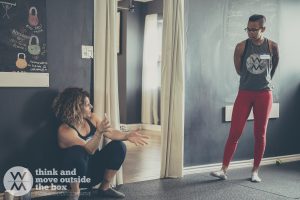
Lastly, when you get providers from various backgrounds in the same room, it allows for a tremendous networking opportunity. All of my Moving with the Maestro courses are open to anyone for this exact reason. Trainers can converse with massage therapists. PTs can converse with yoga instructors. Not only does this allow for referral relationships to be created, but it creates a setting where someone can get inspired by someone else’s story and decide they want to take their career in a different direction or add something to their skill-set. We have to remember, we’re all in this together.
What’s the most important piece of advice, tip or trick related to movement education (or not!) you’ve received so far?
The most important piece of advice that I received that relates to any service-based industry is: You can’t care more than your patients. A professor (shoutout to Dr. Weaver) from PT school said this to us during class one day, and it was something I didn’t understand at first, and thought was kind of harsh… and then I started practicing, and it all became very clear. Most people go into professions like physical therapy, yoga, personal training, coaching, and so on because they care. But there is absolutely such a thing as caring too much. Go ahead and give 100%, but only if your client is willing to do the same.
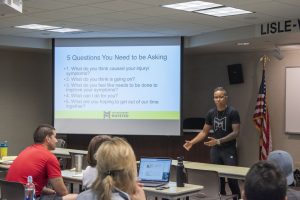
Shante’s Movement Philosophy
In your philosophy on movement, you put an emphasis on assessment. What do you think yoga teachers can learn from your opinion in that regard?
I think there are two big things to take from this concept of assessing and not guessing.
1 – Figure out the reason why someone is moving the way they are moving. Don’t just try to get them to fit into a shape. People do the things they do for a reason. It could be fear, it could be lack of awareness, or it could be structural. An assessment will give you the answer, and thereby the most appropriate next steps.
2 – No two people move the same, so we need to champion the process more than the pose. Movement is a journey, not a destination. Yes, I care that you got to that final position, but I care more about HOW you got there. This is observing movement. This is assessing movement. This is what gives you the answers so that you can help people do what they want to do, and do it better.
What do you think there is not enough of in movement classes (any kind of gym class, yoga, team sports, etc.)? Too much of?
I think there’s too much standardization and not enough celebration of individuality. Like I said in the last question, no two humans move the same, and yet here we are in classes all trying to fit into the same box. Now, there’s a difference between individualized movement and movement that’s going to jack you up, but I think overall we need a more welcoming environment that encourages people to actually feel their body and connect with what they’re doing instead of trying to move like someone else and then asking if they did it ‘right’.
What’s the role of breathing in your movement universe? What do the majority of people get wrong about breathing?
Breathing is my jam, and I love nerding out about it so much that I created an entire online course devoted to it, called Breathing with the Maestro. In regards to the ‘role it plays,’ it’s always my goal to simplify concepts and make them digestible for people. Breathing is the most fundamental movement pattern that we have, and yet so few people understand much, if anything about it, and even fewer people are actually working on/with it because it’s been overly complicated.

One of the first things I teach is that if you’re alive, you’re breathing right. There really isn’t a ‘wrong’ way to breathe. We need to be looking at breathing as a movement pattern, and as such, there may be a more efficient way to breathe. But, again, if you’re alive, you’re breathing right. My main goal is to simply make people more aware of their breathing patterns, and get them to understand that because it is such a fundamental movement pattern, that improving it in any way, no matter how small, can have tremendous benefit. I know that diaphragmatic breathing is all the rage, but the big thing I try to get people to focus on is closing their mouth and breathing through their nose. Your mouth is for eating, your nose is for breathing.
You call yourself a recovering perfectionist. Why is that? Does that play a role in how you approach movement and educating around movement?
The recovering perfectionist tendencies show up mostly with physical content I create. Products like that lend themselves to you revising, and revising, and revising, and never actually putting the thing out. As it relates to movement, perfectionism affected me more in that I tended to only explore things that I could do well.
On the flip side, I think my perfectionist tendencies served me well when it came to assessment, where having a discerning eye made it easier to spot patterns and also things that didn’t fit those patterns. No, there is no such thing as objectively perfect movement, but we can look at movement and see what leaks and aberrant patterns may be present, contributing to (not to be confused with causing) a person’s pain and dysfunction.

What are some of the choices you’ve made that made you who you are as a movement educator?
The biggest choice I made was asking. This is a message I try to spread as often as possible, especially to women. If you want something, ask for it. Yes, work for it, but you must also ask for it. The number one thing that has brought me to where I am today happened 4+ years ago when I asked my mentor Perry Nickelston how to become a RockTape instructor. That day forever changed my life.
In your answers to our previous interview questions, it caught our attention that you called the nervous system queen (“We must remember that the nervous system is queen. All movement, strength, flexibility… it’s granted by her. As such, if we want to change any of those things, we must communicate with the nervous system.”). Can you tell us a bit more about how you work with the nervous system? In the context of yoga, how do you think instructors should approach that aspect of the human body & human movement?
Real talk: If you’re working with a living human being, you CAN’T NOT work with the nervous system. Every single thing a person does is granted by their nervous system. Every single thing that you do is picked up by that person’s nervous system. As such, we need to realize that if we want to have a positive impact on that person, if we want that person to change, to move in a specific way… we must appeal to their nervous system.
How you do this comes in more flavors than Ben & Jerry could ever dream up. The number one thing to remember is that it will ultimately be dictated by the person in front of you. This, again, ties into assessment. Figure out what matters to that person. Figure out what scares that person. Figure out what’s easy for that person. This is all information about their nervous system. That feeling of tension or tightness? That’s the nervous system talking to you. Then you use this information to speak the same language as that person’s nervous system and your chances of helping them increase exponentially.
In the context of yoga, instructors can consolidate all of what I just said into one simple phrase I heard from Lenny Parracino: Expose, don’t impose. Nothing good ever came from anything forced.
Pain. What is pain for you? Is it a verb or a noun? There are many interpretations of pain in the modern PT world. Why do you think there’s no consensus around what pain is?
Plain and simple, pain is an EXPERIENCE, not a thing. It is a complex experience that is produced as an output from our brain, created by a multitude of inputs. Pain is our brain’s response to threat, perceived or actual. In other words, pain is the opinion of the brain after it has received and interpreted a whole bunch of information from our body, our environment, our thoughts, and anything that we’ve experienced in any way (including having simply heard or read about something) in the past. Pain is good. Pain is protective. Pain is necessary for life: it keeps you from doing things that would kill you! I think the fact that significant confusion remains around the topic of pain speaks to the complexity of pain and the fact that it is not a thing, but rather an individualized, unique experience.
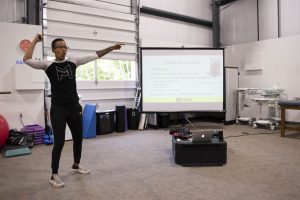
Of note, pain science is spreading and becoming increasingly popular. Folks are educating themselves, and we are absolutely beginning to see a shift in how patients are being treated and how clinicians are delivering their services. The progress may be very slow, and very small, but it’s still progress.
Still on the topic, you also said that “the thing we receive the least amount of education on during school is: pain. This is a problem. I want to be part of the solution.” Why do you think the topic should be a more prominent part of the curriculum/education?
It’s because it’s the number one thing that people come to see us for. I would contend that it’s likely one of the main reasons people go to or at least start going to yoga. How can we help people with something we don’t understand? Even more pressing, it becomes increasingly difficult to believe things that we don’t understand.
So many people, particularly women, spend years suffering from pain, with their providers not believing them… because they don’t understand pain.
They think of it as a singular, physical thing that can be seen on an MRI, or tested for in the lab… and that couldn’t be farther from the truth. Businesses are built on solutions to problems. We are in the business of helping people get out of pain. How can we do that if we don’t understand what pain is in the first place? How can we provide a solution if we don’t understand the problem?
Shante’s Views on Yoga
What’s your experience with yoga? How do you feel about it? Why do you think yoga practitioners are attracted to you and your movement philosophy?
I am a yoga dabbler. I’ve typically turned to it when I needed a break from my preferred method of working out (CrossFit), or if I physically couldn’t do other things. Yes, even the Maestro gets injured. I feel that yoga, like CrossFit, has become something it was not intended to be, and that’s not a good thing. I think people glorify poses in yoga the same way people glorify heavy lifts in CrossFit, with both parties putting on a happy face for the camera but then spending each day in a world of pain because they’re abusing their body. I think there can be a tremendous amount of strength gained from yoga, but in and of itself, it’s not enough. Bodyweight strength is great, but external loading is imperative for true resilience.
Additionally, I think that yoga, just like CrossFit, is but one tool in the toolbox. Staying healthy is quite simple: Do more of what you’re not doing a lot of. We do what we’re good at. We do what we enjoy doing (which is typically that which we’re good at). We do what speaks to our nervous system. We need balance, though. We need to do more of the other stuff.
Bendy people go to yoga to get more bendy. Strong people go to CrossFit to get stronger. It’s when we see those people crossing over and doing more of what they’re not doing a lot of that the real magic happens.
I think yoga practitioners enjoy my philosophy because it’s easy to understand, there are no absolutes, and it focuses on listening. From the more logistical side of things, my penchant for breathwork and the nervous system creates a shared language that causes yoga practitioners to be open to hearing more from me, and then when I follow it up by telling them that they can move however they want, that more is not better, and that I can help them understand their pain (all in a digestible fashion), it resonates even more.
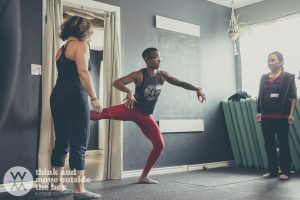
What do you recommend every yogi do so they can balance out their movement diets?
Pick things up and put them down. Preferably heavy things.
You mentioned you wanted to connect more with the yoga community. Or have you noticed that the yoga community wants to connect more with you? Either way, why is that?
I mentioned that I want to connect more with the yoga community for two reasons: 1 – We’re all in this together. 2 – I believe I can help those who are looking for it. Many of the things that yoga practitioners report are overuse injuries that we, as physical therapists, see in the hypermobile population, particularly those who refuse to stop doing whatever it is that is hurting them. I’m not here to tell anyone to forever stop doing something that they love. I’m here to educate folks so that they have awareness and can make the necessary changes that will allow them to keep doing what they love for the rest of their lives.

Foundation versus advanced poses. How do you feel about “advanced” poses in yoga? Headstand, arm balances, etc.
I really don’t think there is such thing as a bad movement. I do however think there are movements that your body is not prepared for, and other movements that your body, given your specific anthropometrics [the specific measurements and proportions of one’s body, editor’s note], will never be able to do. I’m far less concerned with arm balances than I am with feats of extreme flexibility. Go slowly, build the foundation, layer the sexy stuff on top, and make sure you have fun.
We often see you share about charging your worth and how physical therapists & movement educators don’t have to live a poor lifestyle. This is a topic that goes for teaching yoga too—what’s your philosophy on that? Why do you think it matters?
As my good friend Danny Matta says, “When people pay, they pay attention.” Want someone to value something? Charge for it. Want people to devote more time and effort? Charge for it. I think we could all benefit from analyzing our relationship with money and figuring out why we hold the beliefs we do and why we act the way we act.
Making money is important. It’s safety. It allows us to continue doing what we enjoy doing, and ultimately, it allows us to help more people.
General Curiosities
A book that changed your life?
The 4 Hour Work Week by Tim Ferris. Super clichéd, perhaps, but I read it at exactly the time I needed to read it. I got started on that lifestyle very shortly after.
The first thing you do when you wake up?
Check Instagram. Call me obsessed. I don’t care. I’ve made incredible connections there, I run my business on there, and it’s not at all a stressful thing for me. I enjoy it, which is why I do it first thing in the morning. As for other morning routines, I make my bed every morning, and I drink 16 oz of a lemon-Himalayan sea salt-water concoction. No journaling or meditating or anything like that for me. Never been my jam.
What are three IG accounts you like to go check out even if their posts don’t appear in your feed?
Honestly, I see the people who I want to see. I’m glad you asked this question because I think it’s important for people to remember this: Curate your feed and create your ideal Instagram experience. The accounts you interact with the most will be the ones that Instagram shows you. So, if you like an account, interact with it. If an account makes you feel bad, stop following it. You should enjoy the content (or it at least should not make you feel bad) of everyone that shows up in your feed.
Instagram and social media get a bad rap, but I don’t think there’s enough accountability placed on the user. You don’t have to look at those other accounts. You don’t have to follow that person you don’t like. Like the things that make you smile. Follow the accounts that make you happy. Reach out to the people who inspire you. Instagram is what you make it.
As for a top 3, I really don’t have one. I suppose if forced to choose, I’d go with: @caliloveofficial, @atxphysicaltherary, @drsmashlove. No, not all of them are movement-related, and that is why I continue to love IG each and every day 😉
Check out Shante’s Instagram and website, where you’ll find more information about her and her work as a PT and social media pro.
Edited by Ely Bakouche
Enjoyed reading this article? Consider supporting us on Patreon or making a one-time donation. As little as $2 will allow us to publish many more amazing articles about yoga and mindfulness.


